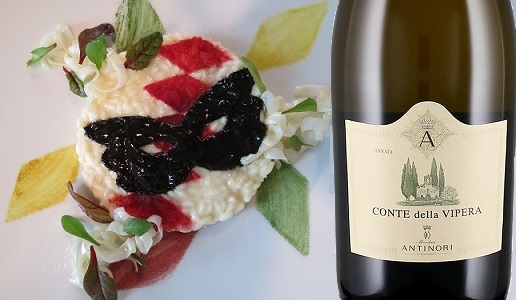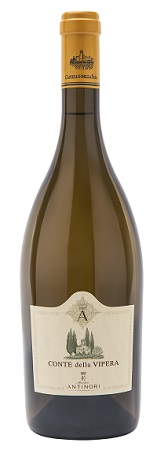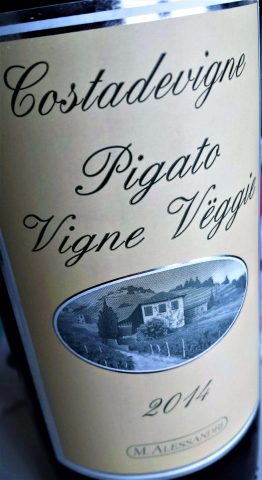Risotto with a squid-ink mask and a red-beet sauce

Created by Chef Luca Landi of the Lunasia restaurant in Viareggio, this dish is a tribute to this city’s historic Carnival. We suggest pairing it with a Conte della Vipera 2018 Castello della Sala dei Marchesi Antinori.
The dish is dedicated to Burlamacco, the official mast of the Viareggio Carnival, a risotto that Chef Luca Landi of the Lunasia restaurant, situated inside Viareggio’s Plaza and de Russie Hotel, created for the event.
Burlamacco, with his red, white and black argyle suit inspired this chef to create this special recipe that has an intense and distinct flavor. His idea was to reproduce the colors of the costume on the plate, while the rippled cuttlefish noodles recall streamers and the two sauces of squid ink and beets create an interesting contrast of flavors.  The chef also wanted this dish to be a tribute to an historic Tuscan recipe, one typical to the Livorno coast.
The chef also wanted this dish to be a tribute to an historic Tuscan recipe, one typical to the Livorno coast.
This dish will be offered as a menu special at the Lunasia restaurant throughout the carnival period (February 1-25).
Ingredients for 6 people:
480g of rice, 1kg cuttlefish, 300g beets, 30g tomato paste, white wine as needed, vinegar, 2l vegetal broth, extra-virgin olive oil, butter, isinglass, parmigiana, 10g dried kombu kelp, garlic, sage, chili pepper, white onion and parsley.
Directions:
Clean the cuttlefish placing in separate containers the heads, ink in its sack, wings and skin, the guts and the body.
Squid-ink sauce: sauté the garlic, sage and chili pepper, add in the wings, skin and guts, a little tomato paste, douse with some white wine and vinegar. Add in the squid ink and then some broth and cook for 15 minutes.
Once done, blend with a mixer and add in the isinglass, 4g per 100g of sauce. Spread out the black sauce on acetate paper and let it solidify in the refrigerator. Cut mask shapes out of the sauce, remove them and place back in the refrigerator.
Cuttlefish noodles: Place the cleaned cuttlefish bodies on top of each other. Freeze them and then cut them into fine slices using meat slicer and place them on parchment paper.
Red-beet sauce: bake the beets covered in salt for 40 minutes at 150°C until the reach 85° on the inside. Clean off the salt, peel the skins off and blend with EVOO and a few drops of white vinegar. Salt to taste.
Save the beet skins and let them dry. Once they are very dry, blend them to obtain a fine powder.
The risotto: sauté the white onion in a pan with EVOO and a little butter and toasted the rice in it. Douse with white wine. Add in broth previously prepared using left over cuttlefish and some kombu kelp sheets and finish cooking. Adjust the salt and mix in some EVOO and Parmigiano.
Plate presentation: Once the rice is done, spread some red-beet sauce and squid-ink sauce on each plate, cover this with rice and complete with some freshly pan-cooked cuttlefish noodles.
Garnish with young beet leaves and the dried red-bet powder. To top it off, place a squid-ink mask on each plate and let it melt with the heat of the rice.
 Wine to pair:
Wine to pair:
(edited by Stefania Vinciguerra)
Conte della Vipera 2018 Castello della Sala dei Marchesi Antinori
Straw yellow with greenish hues. Intense aromas of herbs, sage, broom flowers, tomato leaf, thyme and anise, then grapefruit and bergamot. Agile and distinct taste, very intense. In the aftertaste again notes of citrus and aromatic herbs.
Production area: The vineyards selected to be utilized for the Conte della Vipera are located at an altitude between 825 and 1050 feet (250-350 meters) above sea level on soils rich in marine fossils. The property is the Castello della Sala, located in the Umbria region, not far from the Tuscan border, about 18 kilometers from the historic city of Orvieto.
Grape varieties: Sauvignon blanc and Sémillon.
Grape harvest: Picking of the Sauvignon Blanc grapes began towards the end of August and concluded with the Sémillon harvest towards the middle of September. The decision to pick the Sauvignon Blanc and Sémillon grapes was taken on the basis of the balance between the sugar concentration and the maximum expression of the aromatic varietal aromas of the crop. The berries, harvested manually, went immediately to the cellar where they were chilled by means of a refrigerated conveyor belt which, lowering the temperature level before pressing, helped to preserve intense varietal aromas.
Wine making: After this soft pressing, the must went into stainless steel fermentation tanks where it fermented at a temperature held to a maximum of 61° Fahrenheit (16° centigrade). After this operation, the wine was conserved at a temperature of 50° Fahrenheit to block a successive malolactic fermentation and maintain, unchanged, the wine’s flavor and aroma. The two grape varieties were then blended together to enable the one part of “complete” the other. Fresh, savory, vital, and lightly aromatic the Sauvignon, supple and tropical the Sémillon.
Serving temperature: around 50* Fahrenheit
Curiosity: The wine takes its name from first proprietors of the Castello della Sala, and the label shows the 13th century Saint John’s Chapel (the Cappella di San Giovanni) situated on the estate.
Related Products
| Product | Producer | Date of publication | Author | Read | |
|---|---|---|---|---|---|

|
Castello della Sala
|
07/04/11 | Redazione |
The Castle is a 15th century Monaldeschi fortress that today belongs to the Antinori family who have turned it into a pearl of winemaking in Italy. Here tradition and innovation coexist in a... Leggi tutto |

 Italiano
Italiano








